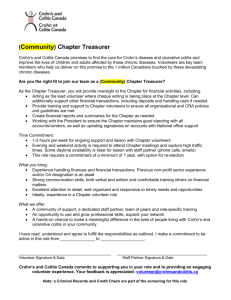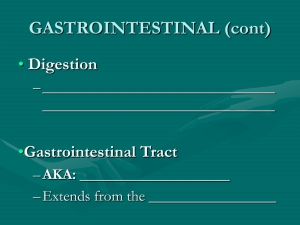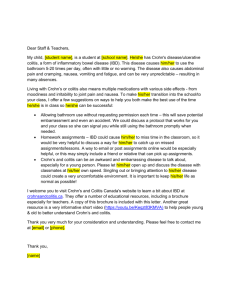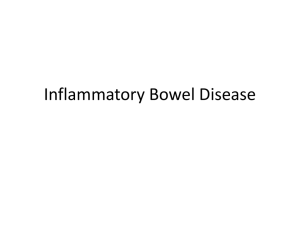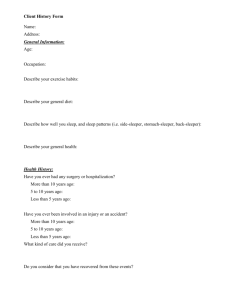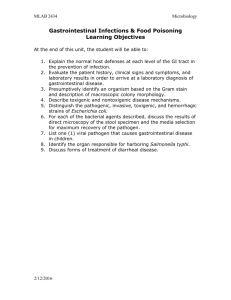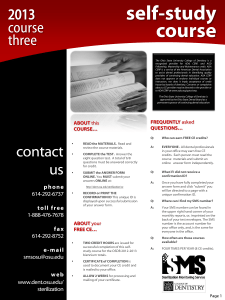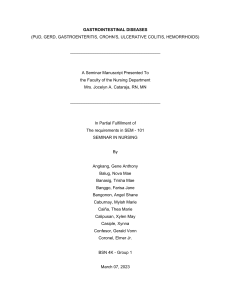git disorders
advertisement
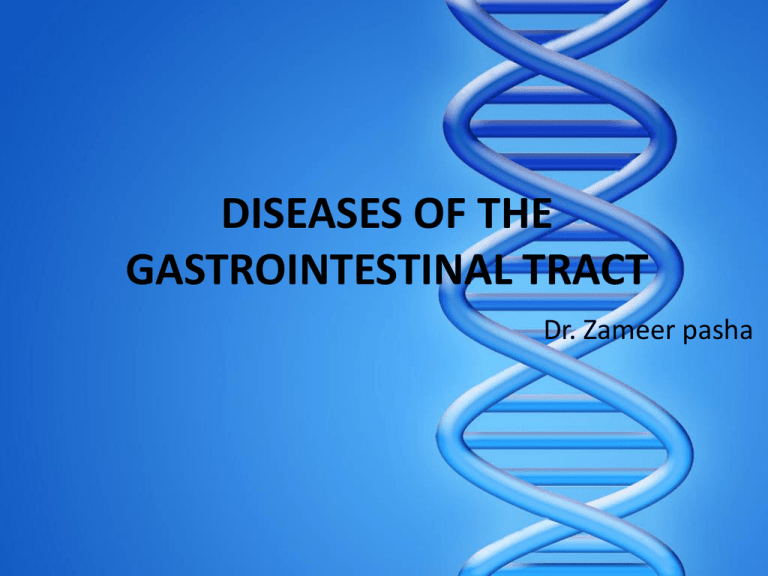
DISEASES OF THE GASTROINTESTINAL TRACT Dr. Zameer pasha DISEASES OF THE UPPER DIGESTIVE TRACT • Gastroesophageal Reflux Disease • Hiatal Hernia DISEASES OF THE LOWER DIGESTIVE TRACT • Disorders of the Stomach • Disorders of the Intestines GASTROINTESTINAL SYNDROMES • Eating Disorders: Anorexia and Bulimia • Gardner’s Syndrome • Plummer-Vinson Syndrome • Peutz-Jeghers Syndrome • Cowden’s Syndrome Introduction • Dental health care workers are expected to recognize, diagnose, and treat oral conditions associated with gastrointestinal diseases, as well as provide dental care for afflicted individuals • To provide safe and appropriate dental care, proper diagnosis of oral manifestations of gastrointestinal disorders, homeostasis, risk of infection, drug actions and interactions, the patient’s ability to withstand the stress and trauma of dental procedures. • Gastrointestinal tract is a primary route for drug administration, absorption, biotransformation. Many dental patients require drug therapy in which pharmacokinetic parameters may be altered by gastrointestinal and hepatobiliary dysfunction. Gastroesophageal Reflux Disease [GERD] • One of the most commonly occurring diseases affecting the upper gastrointestinal tract. • Gastric contents (chyme) passively move up from the stomach into the esophagus. • Heartburn is the cardinal symptom of GERD and is defined as a sensation of burning or heat that spreads upward from the epigastrium to the neck. • Esophagitis, esophageal ulceration, stricture, dysplasia and dysphagia are noticed. • Chest pain is seen and can mimic the symptoms of an acute cardiovascular disorder and is often the impetus for patients seeking medical care. • GERD complications include premalignant and malignant conditions of the esophagus. Gastroesophageal Reflux Disease [GERD] • The relaxation of the lower esophageal sphincter for the purpose of relieving pressure in the stomach (from gas and the ingestion of food) is called the “burp” mechanism. • The gastroesophageal junction, which prevents the regurgitation (retrograde or upward flow) of gastric contents, is composed of an internal lower esophageal sphincter. • The exact cause for the incompetence of this sphincter is not known, but salivary insufficiency, obesity, pregnancy may all cause GERD. • Oral health considerations: Dysguesia (foul taste), sensitivity, dental erosion. • Management : Lifestyle modifications, • Omeprazole etc Hiatus Hernia • The esophagus passes through the diaphram. This hiatus causes an anatomic narrowing of the opening of the stomach. • Some patients have a weakened or enlarged hiatus which causes the a part of the stomach to herniate into the chest cavity. • Three types: – Sliding – fixed – complicated. • Main symptom – chest pain (radiating pain similar to heart attack). • Other symptoms – dry cough, hiccups and increased contractile force of the heart. • Oral manifestations are similar to GERD. Disorders of the stomach • Peptic ulcer disease: is a common benign ulceration of the stomach. • Etiology : – Genetic – Increased acid production – H pylori infection(Helicobacter pylori) – Cigarette smoking – Increased stress Epigastric pain is the most common complaint. Some of them have life threatening complication like haemorrhage, perforation of lining and obstruction. Gastric ulcer – pain aggravated with food Duodenum ulcer – pain relieved with food • • • • • Dental patient with history of peptic ulcer – Avoid stress to the patients Avoid NSAIDs Anticholinergic drugs taken for ulcers cause dry mouth Antacids contain Ca, Mg, Al salts which bind with some antibiotics hence should be avoided. • Chronic bleeding may lead to anemia hence determining the blood parameters is very important. Inflammatory bowel disease ULCERATIVE COLITIS AND CROHNS DISEASE • Ulcerative colitis involves the mucosa and submucosa of the colon. • Crohn’s disease is an inflammatory condition involving all layers of the gut. • The precise etiology and pathogenesis of ulcerative colitis and Crohn’s disease are unknown, • oral signs of inflammatory bowel diseases, include pyostomatitis vegetans, aphthous ulcerations, cobblestone appearance of the oral mucosa, oral epithelial tags and folds, gingivitis, persistent lip swelling, lichenoid mucosal reactions, granulomatous inflammation of minor salivary gland ducts, candidiasis, and angular cheilitis. • The hallmark of ulcerative colitis is rectal bleeding and diarrhea. The frequency of bowel movements and the amount of blood present reflect the activity of the disease • The oral changes that occur in ulcerative colitis cases are nonspecific and uncommon, with an incidence of less than 8%. Aphthous stomatitis of the major and minor variety has been reported in patients with active ulcerative colitis. • Chronic bleeding can be associated with ulcerative colitis. Prior to dental procedures, blood studies that include hemoglobin, hematocrit, and a red blood cell count should be undertaken to rule out the presence of anemia. • Recurrent aphthous ulcers are the most common oral manifestation of Crohn’s disease. pyostomatitis vegetans, cobblestone mucosal architecture, and minor salivary gland duct pathology represent granulomatous changes that constitute the hallmark of Crohn’s disease Gastrointestinal Syndromes • Anorexia and Bulimia • Anorexia involves individuals who intentionally starve themselves when they are already underweight. • Bulimia nervosa consume large amounts of food during “binge” episodes in which they feel out of control of their eating, They then try to prevent weight gain after such episodes by vomiting, using laxatives or diuretics, dieting, and/or exercising aggressively. • Both of these disorders seem to be most prevalent in industrialized societies. • Anorexia and bulimia are both considered psychiatric disorders with physical complications. • The cardinal oral manifestation of eating disorders is severe erosion of the enamel on the lingual surfaces of the maxillary teeth. • Examination of the patient’s fingernails may disclose abnormalities related to the use of fingers to initiate purging. • Mandibular teeth may be affected but not as severely as the maxillary teeth. Parotid enlargement may develop as a sequela of starvation. • The dentist should be aware of a possible eating disorder when these symptoms are encountered and should take steps to arrange for referral to other practitioners • Gardner’s syndrome: consists of intestinal polyposis (which represents premalignant lesions) and multiple impacted supernumerary (extra) teeth. Osteomas, epidermoid cysts . • Plummer-Vinson Syndrome: Iron deficiency with esophageal stricture and webs. • Peutz-Jeghers Syndrome: multiple intestinal polyps throughout the gastrointestinal tract but primarily in the small intestine. Pigmentation (present from birth) of the face, lips, and oral cavity is a hallmark of this syndrome

